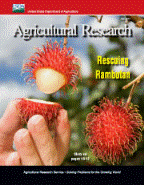United States Department of Agriculture: Agricultural Research Service, Lincoln, Nebraska

Agricultural Research Magazine
Date of this Version
2-2013
Document Type
Article
Citation
Agricultural Research February 2013
Abstract
Like any structure, a root has its own architecture. Some roots burrow straight down into the soil. Others scatter web-like tentacles. However they turn out, root systems play a critical role in the health and survival of today’s crops. That’s why Agricultural Research Service scientists in Ithaca, New York, have developed a new tool for studying root architecture, one that brings them out in three-dimensional color. It’s a major step forward in a challenging field.
Studying root-system architecture can be extremely difficult because the opaque nature of soils makes it hard to capture and visualize the root structures. Also, field conditions, such as soil chemistry and soil moisture, can vary from one site to the next, and changing conditions dramatically affect the shape, size, and health of a root system. But root structure, health, and formation have become important traits of interest in recent years as scientists search for varieties of crops with roots that equip them to adapt to drier habitats and changing climates.
Scientists have grown plants hydroponically in pots and on plates and have used tools ranging from magnetic resonance imaging to computer-assisted tomography to study root architecture. The latest technology includes transparent gels that allow them to observe roots at different stages of development as the root and plant grow together in a kind of suspended animation.
Included in
Agriculture Commons, Animal Sciences Commons, Food Science Commons, Plant Sciences Commons

